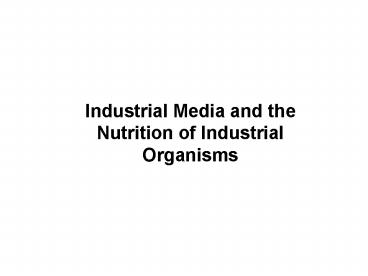Industrial Media and the Nutrition of Industrial Organisms - PowerPoint PPT Presentation
1 / 20
Title:
Industrial Media and the Nutrition of Industrial Organisms
Description:
Industrial Media and the Nutrition of Industrial Organisms THE BASIC NUTRIENT REQUIREMENTS OF INDUSTRIAL MEDIA Carbon or energy requirements Nitrogen is found in ... – PowerPoint PPT presentation
Number of Views:492
Avg rating:3.0/5.0
Title: Industrial Media and the Nutrition of Industrial Organisms
1
- Industrial Media and the Nutrition of Industrial
Organisms
2
THE BASIC NUTRIENT REQUIREMENTS OF INDUSTRIAL
MEDIA
- Carbon or energy requirements
- Nitrogen is found in proteins including enzymes
as well as in nucleic acids - Minerals
- Growth Factors
3
Average composition of microorganisms ( dry
weight)
4
CRITERIA FOR THE CHOICE OF RAW MATERIALS USED IN
INDUSTRIAL MEDIA
- Cost of the material
- Ready availability of the raw material
- Transportation costs
- Ease of disposal of wastes resulting from the raw
materials - Uniformity in the quality of the raw material and
ease of standardization - Adequate chemical composition of medium
- Presence of relevant precursors
- Satisfaction of growth and production
requirements of the microorganisms
5
SOME RAW MATERIALS USED IN COMPOUNDING INDUSTRIAL
MEDIA
- Corn steep liquor
- Pharmamedia
- Distillers soluble
- Soya bean meal
- Molasses
- Sulfite liquor
- Other Substrates (alcohol, acetic acid, methanol,
methane, and fractions of crude petroleum)
6
Corn steep liquor
- This is a by-product of starch manufacture from
maize. - As a nutrient for most industrial organisms corn
steep liquor is considered adequate, - rich in carbohydrates, nitrogen, vitamins, and
minerals. - highly acidic, it must be neutralized (usually
with CaCO3) before use.
7
Approximate composition of corn steep liquor ()
8
Pharmamedia
- yellow fine powder made from cotton-seed embryo.
- It is used in the manufacture of tetracycline and
some semi-synthetic penicillins. - rich in protein, (56 w/v) and contains 24
carbohydrate, 5 oil, and 4 ash - rich in calcium, iron, chloride, phosphorous, and
sulfate.
9
Distillers soluble
- by-product of the distillation of alcohol from
fermented grain. (maize or barley) - It is rich in nitrogen, minerals, and growth
factors.
10
Composition of maize distillers soluble
11
Soya bean meal
- The seeds are heated before being extracted for
oil that is used for food, as an antifoam in
industrial fermentations, or used for the
manufacture of margarine. - The resulting dried material, soya bean meal, has
about 11 nitrogen, and 30 carbohydrate and may
be used as animal feed. - Its nitrogen is more complex than that found in
corn steep liquor - not readily available to most microorganisms,
except actinomycetes. - It is used particularly in tetracycline and
streptomycin fermentations.
12
Molasses
13
Sulfite Liquor
- Sulfite liquor (also called waste sulfite liquor,
sulfite waste liquor or spent sulfite liquor) is
the aqueous effluent resulting from the sulfite
process for manufacturing cellulose or pulp from
wood. - During the sulfite process, hemicelluloses
hydrolyze and dissolve to yield the hexose
sugars, glucose, mannose, galactose, fructose and
the pentose sugars, xylose, and arabinsoe. - Used as a medium for the growth of microorganisms
after being suitably neutralized with CaCO3 and
enriched with ammonium salts or urea, and other
nutrients.
14
- It has been used for the manufacture of yeasts
and alcohol. - Some samples do not contain enough assaimilable
carbonaceous materials for some modern
fermentations. - They are therefore often enriched with malt
extract, yeast autolysate, etc.
15
GROWTH FACTORS
- Not synthesized by the organism
- Must be added to the medium.
- Function as cofactors of enzymes and may be
vitamins, nucleotides etc. - The pure forms are usually too expensive for use
in industrial media - Growth factors are required only in small
amounts.
16
Some sources of growth factors
17
Some Potential Sources of Components of
Industrial Media
- Carbohydrate Sources
- Cassava
- Sweet potato
- Yams
- Cocoyam
- Millets
- Rice
- Sorghum
- Jerusalem artichoke
18
Protein Sources
- (a) Peanut (groundnut) meal
- (b) Blood meal
- (c) Fish Meal
19
THE USE OF PLANT WASTE MATERIALS IN INDUSTRIAL
MICROBIOLOGY MEDIA SACCHARIFICATION OF
POLYSACCHARIDES
20
- Not only plentiful but that in contrast with
petroleum, a major source of chemicals, they are
also renewable. - Contain large amounts of polysaccharides which
are not immediately utilizable by industrial
microorganisms - Need to be hydrolyzed or saccharified to provide
the more available sugars. - Thereafter the sugars may be fermented to ethyl
alcohol for use as a chemical feed stock. - The plant polysaccharides starch, cellulose and
hemicelluloses.































